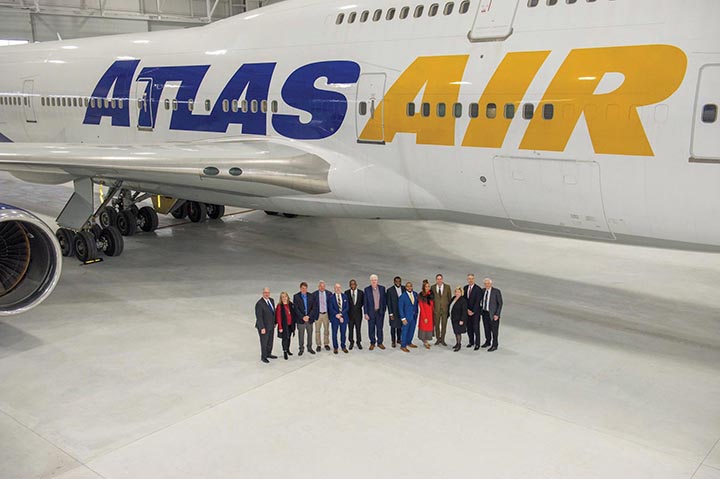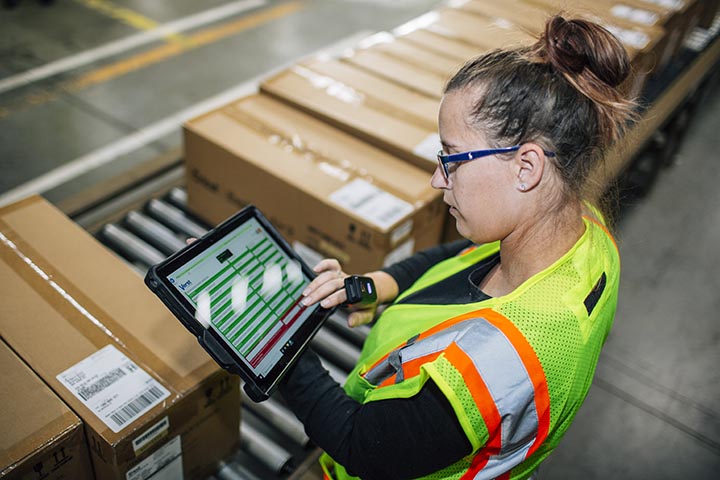
By Greg Paeth
It’s a pretty good bet that 2021 will prove to be an extraordinary year for the tightly intertwined logistics and transportation industries in Northern Kentucky.
 That’s saying quite a bit in the wake of 2020, which will be cemented in our memories as the year that COVID-19 wreaked havoc on just about every aspect of our lives. Consider three vitally important stories that are expected to unfold this year:
That’s saying quite a bit in the wake of 2020, which will be cemented in our memories as the year that COVID-19 wreaked havoc on just about every aspect of our lives. Consider three vitally important stories that are expected to unfold this year:
• Amazon, the million-ton gorilla of online retailing, is expected to open the first phase of its $1.5 billion air hub and distribution center in Northern Kentucky sometime before the 2021 holiday season. The company said it will create some 2,000 jobs once the entire facility is up and running on property owned by the Cincinnati/Northern Kentucky International Airport (CVG), where Amazon is expected to handle 64 flights every day.
• Repairs have been made to the Brent Spence Bridge, which was damaged in November by a fiery tractor-trailer collision. The bridge carries 160,000 cars per day – and it was designed to carry just 80,000. It is also one of the busiest trucking routes in the United States, with freight equaling 3% of the nation’s gross domestic product crossing the bridge each year. Northern Kentucky officials have long been advocating for funding to upgrade the bridge, which originally opened in 1963. Officials hope the crash and shutdown, which lasted nearly six weeks, will shine the light once again on the need to upgrade the critically important north-south truck route – one of the reasons why Kentucky has established itself as a logistics mecca for the country.
• For the first time in 20 years, the Transit Authority of Northern Kentucky – the TANK bus system – will introduce what it calls a substantial “redesign” of its services as it eliminates six routes and begins to concentrate its efforts in high-population areas along existing routes. The move is designed to counter a decline in ridership in the region and elsewhere in the country that has been caused, in part, by low gas prices.
As the potential impact of these topics indicates, 2021 may present an unsettling blend of good news and bad for everyone who’s immersed in logistics and transportation in the Cincinnati/ Northern Kentucky metropolitan region, where it’s estimated that more than 106,000 people work in those broadly defined categories. Of those, some 30,000 workers make their homes in Boone, Campbell and Kenton counties, according to Northern Kentucky Tri-County Economic Development Corp. (Tri-ED), which focuses on economic development in three counties that have a combined population of about 385,000.
In her job as the CEO of CVG, Candace McGraw had a free front-row seat for the complete spectrum of pandemic-related news.
At one level, the airport and most of its employees managed to avoid skyrocketing infection rates that crippled some businesses, said McGraw, who oversees an institution that is said to have an annual economic impact of $6.8 billion and 14,500 “badged employees” who work for the airport or other companies located on airport property.
Despite becoming only the third airport in the country to receive a COVID-related “Airport Health Accreditation” from an international trade association in mid-September, passengers stayed away and numbers declined dramatically throughout 2020.
“With the pandemic, our passenger levels are down, of course, but compared with all airports throughout the country, we’re tracking – thankfully – slightly above the national level for airports our size. So we will likely finish this year with about 35% of the passengers we had in 2019, and that’s faring better than some of my airport colleagues,” McGraw said.
For 2019, the airport reported 9.1 million passengers.
As the COVID-19 crisis worsened late in the year, McGraw made it clear that CVG and the airline industry don’t expect an immediate bounce back. For 2021, passenger levels are projected at 50% of the 2019 total, McGraw said.
“For 2021, our budget is projecting that we’ll be at about 50% of the 2019 passenger levels,” said McGraw, who noted that airfares now rank 92nd in the country with an average of $215, according to the U.S. Department of Transportation.
She also said that because of COVID-19, “cargo is booming.”
“Throughout the pandemic, cargo is operating at (Christmas) holiday volumes and continues to do so,” said McGraw. In mid-November, she said, shipments were up 13.5% over last year, which had been a record year for the seventh-largest cargo airport in the country. “Cargo continues to be the bright spot. E-commerce has been accelerated by this pandemic.”

Kentucky boasts that it’s the only state in the country with three international air shipping hubs: UPS in Louisville, and DHL and Amazon in Northern Kentucky, where those two companies temporarily share the DHL building, with some 2,000 DHL employees handling 90% of the German shipper’s deliveries to the U.S.
Amazon, which broke ground on its Air Hub in May of 2019, operates 11 fulfillment centers in the state, according to the Kentucky Cabinet for Economic Development (KCED). The company said that since 2010 it has created 14,500 full and part-time jobs in Kentucky, where it has invested $15 billion in infrastructure and wages.
Atlas Air, an airfreight firm based in Purchase, N.Y., that has a “strategic relationship” with Amazon, is scheduled to open a new office a few miles from CVG in 2021. Atlas and other companies under its corporate umbrella operate the world’s largest fleet of Boeing 747 freight aircraft, the company said.
FEAM Aero opened a $19 million, 103,000-s.f. cargo hangar at CVG in January 2020. It accommodates wide-body 747 aircraft for maintenance, repair and overhaul. The company services DHL, WOW Air, Atlas Air and Amazon Air’s fleet at CVG. The project created 100 new, high-paying aircraft mechanic jobs, increasing FEAM Aero’s employment at CVG to 300 jobs.
“Among CVG’s strategic goals are to grow air cargo operations, and develop available airport land, both of which are achieved with this project,” McGraw said.
FedEx also has a substantial presence in Northern Kentucky, where 500 people work in a ground-package facility, according to KCED.
Verst Logistics in Walton, which has about 1,900 employees in five states and is a major player in Northern Kentucky and elsewhere in the country, also felt the impact of the pandemic in both positive and negative ways.
“We operate distribution centers for the largest grocery chain in the U.S. and as you can imagine, their volume has been through the roof,” said Paul Verst, chairman and CEO. “Also, with so many people working or staying at home, our e-commerce/ fulfillment customers are having a record year as well since so many people are ordering products online. From a negative perspective, our automotive customers closed plants for four to six weeks so we were forced to furlough employees on a temporary basis, but most – if not all – are back to work now.
“We believe consumers will continue to purchase more products online after the pandemic is over, so we see a continued exponential increase in our e-commerce business,” said Verst, adding that revenues for 2020 have increased by “double digits.”
“The COVID-19 pandemic has fundamentally changed the way we all do business. Any company who thinks business will return as usual when this is over will more than likely not be here in the next year or two,” he said.
It was a similar story at Total Quality Logistics (TQL), a Cincinnati company that describes itself as the largest privately held freight broker in the country.
“National freight activity is drastically elevated compared to 2019 and TQL is certainly seeing this in day-to-day business,” said TQL President Kerry Byrne, whose company was ranked in November as the largest privately held company in Cincinnati by the Cincinnati Enquirer, with 2019 revenues of about $3.4 billion. “Grocery and e-commerce continue to occupy a large part of that, but we’re also seeing an uptick in lumber and metals due to growth in residential construction.”
Robert Martinchenko, founder of LeanCor and senior vice president at Transplace, also said his company and its customers did well in 2020.
“For our clients who need to transport essential products, we have experienced a remarkable surge in business. Now, we’re supporting shippers in managing the all-important holiday season. Our clients are also telling us that the necessary restocking of shelves will keep them busy until well into first quarter 2021,” Martinchenko said.
The supply chain consulting and training firm made plenty of news in 2020, when it spent $4.4 million to move its headquarters to a new location in Florence and planned to add 53 jobs. Then in September, LeanCor was acquired by Transplace, a logistics technology and services firm in Frisco, Texas.
The Castellini Group of Companies, one of the largest fresh produce distributors in the United States, completed the expansion of its facility in Wilder, Ky., in 2020. The expansion allowed for two of its business lines to work from one facility, making it more efficient.
The 125-year-old company also unveiled an updated logo and website, complete with online ordering and tracking capabilities, and announced that the company would adopt a new, simpler name: Castellini.

Riding into the future
Across Northern Kentucky, many of the employees who keep Amazon, DHL and FedEx humming depend on TANK buses, according to Andrew Aiello, general manager of the bus system for Northern Kentucky.
Aiello saw ridership plummet even though his passengers rode free from March through August. The bus system tried to reduce COVID-19 cases by eliminating contacts with drivers and the handling of currency or bus passes.
As more and more downtown Cincinnati office workers began to work from home and gas prices remained low, monthly ridership fell from about 300,000 to 150,000, said Aiello, adding that the pandemic accentuated passenger decline that had been evident for the last five years.
“Our experience was common for bus systems throughout the country. Bus ridership has seen a decline throughout the U.S,” he said.
TANK redesigned its system in 2020 to offer more frequent service within a quarter mile of more densely populated areas and along routes people use to get to and from work. Changes took effect in January 2021.
“More frequency has worked in other bus systems in the country,” Aiello said.
The redesigned system will increase the number of people within walking distance to frequent transit by 155%, and increase the number of jobs within walking distance to frequent transit by 58%. TANK projects that the number of transportation-disadvantaged individuals within walking distance of frequent transit will increase by 157%; the number of revenue hours needed to operate the new system will decrease by 2.4%; and the number of peak vehicles needed will decrease by over 20%.




















Add Comment